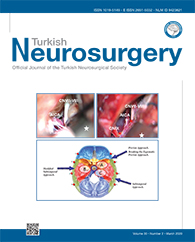2Aksaray University Faculty of Medicine, Department of Anesthesiology and Reanimation, Aksaray, Turkey DOI : 10.5137/1019-5149.JTN.27680-19.2 AIM: To examine the effect of sevoflurane, a halogenated anesthetic used in clinical applications, on oxidative stress and inflammation after an acute traumatic brain injury (TBI) in rats.
MATERIAL and METHODS: Thirty male SpragueâDawley rats were divided into three groups: control (Group 1), trauma (Group 2), and trauma+sevoflurane (Group 3). A diffuse TBI model was created for Groups 2 and 3. Sevoflurane anesthesia was applied 6 hours a day after induced trauma in Group 3. Glutathione (GSH), malondialdehyde (MDA), and tissue myeloperoxidase (MPO) activities were measured in the blood. Tumor necrosis factor alpha (TNF-α), vascular endothelial growth factor (VEGF), and Bax primary antibodies were used to determine the effects of TBI.
RESULTS: MDA was significantly higher in Group 2 than in Group 1. There was a significant increase in tissue MPO levels in Groups 2 and 3 compared with those in Group 1. GSH levels decreased in Groups 2 and 3. Group 3 revealed degenerative changes in neurons and glial cells, vascular enlargement and congestion, and inflammatory cell infiltration around blood vessels. In Group 3, VEGF expression was positive in endothelial and inflammatory cells around blood vessels. Group 3 had positive TNF-α expression in neurons, small granular cells, and glial cells around blood vessels.
CONCLUSION: Sevoflurane administration in acute TBI did not prevent the development of oxidative stress and inflammation.
Keywords : Traumatic brain injury, Sevoflurane, VEGF, BAX antibodies, Rat




